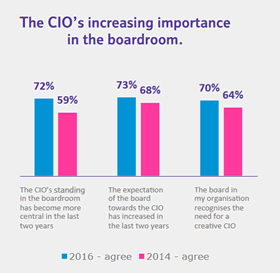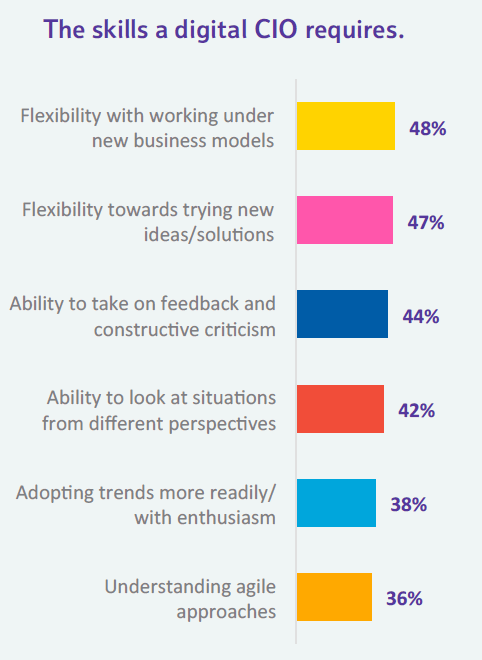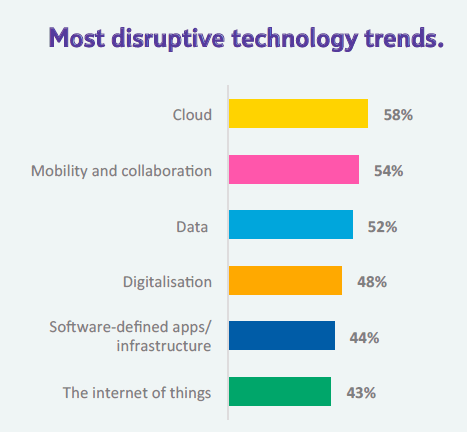A few years ago I attended an event, organized by our partner BT Global Services. When talking about digital transformation, back then a relatively new term, several CIOs reminded how they always had transformed, illustrating their statements with state-of-the-art projects across a broad range of business functions, processes and technologies of the SMAC stack (or third platform, if you prefer) such as cloud computing (a major area for BT Global Services) and big data analytics.
It needs to be said that the average CIO attending the event worked for a large enterprise, the typical customers of BT Global Services. Now that digital business transformation has become a broadly adopted and – admittedly – often somewhat misunderstood term, what are CIOs thinking about digital transformation? Isn’t it just a matter of a few CIOs or projects anymore? How does it impact them?
BT Global Services released the results of research, looking exactly into that. According to the research, conducted by Vanson Bourne, CIOs are effectively embracing digital transformation in order to reinvent the processes and systems of their organizations, obviously with a digital transformation strategy and business goals in mind: from new business models and more efficient processes to enhanced productivity, better customer experience and all the other goals we describe in our digital transformation guide.
With the CIO acting as a catalyst, 76 per cent of large organizations across the world have, or plan to adopt, a ‘multi-speed’ approach to technology-led initiatives. This involves more creativity, more flexibility and a more dynamic operating model.
The evolving role of the CIO in digital transformation

A big question always was and remains what the role of the CIO is in it all.
Do we still ‘joke’ about the fact that CIO stands for ‘Career Is over’ and are organizations swamped with Chief Digital Officers, Chief Transformation Officers and more new roles that, in the end, often are aiming at bridging the almost proverbial (but now and then exaggerated) gap between IT and business and bearing the executive end responsibility of enterprise-wide transformation, along with the CEO and board?
Each business is obviously different and some companies indeed have CDOs in their midst but those who have proclaimed that the CIO’s role was dead might want to consider this: 72 percent of the surveyed senior IT decision makers report that CIOs have been becoming more central in the preceding two years (up from 59 percent in 2014).
The BT CIO report shows that CIOs are clear on the most disruptive technology trends – cloud, mobility and collaboration, and data. According to the report, a fifth of global organizations are already completely cloud-centric, and a further 46 per cent have more than half their applications and infrastructure in the cloud. Source.

True, the role of the CIO is changing and many feel the CIO is forced to send more time maintaining current IT systems, rather than searching for new solutions.
Yet, at the same time 70 per cent of boardrooms expect their CIO to be an innovative force and creative disruptor. You probably know the consequence: bi-modal IT as Gartner likes to call it or, better, a ‘multi-speed’ approach to technology-led initiatives as the press release reminds us.
In the report, BT sees the emergence of a so-called ‘digital CIO’.
Essentially it’s the CIO that knows how to build bridges in a hyper-connected age.
Quote: The smartest CIOs are bridging the gap between business and technology, and responding to both employees and customers expectations simultaneously. What are the skills required to be such a ‘digital CIO’, on top of bridging gaps between business and IT? Based on the answers from participating CIOs and IT executives, they include:
- Flexibility with working under new business models.
- Flexibility towards trying new ideas/solutions.
- Ability to take on feedback and constructive criticism.
- Ability to look at situations from different perspectives.
- Adopting trends more readily/with enthusiasm.
- Understanding agile approaches.
Technology is the primary driver of growth and productivity in this century. Almost everything we do is enabled by technology. Online and mobile channels allow us to do more work with the same number of people and effectively communicate with our guests and employees.
(Robert Webb, CIO, Etihad Aviation Group, in the BT report)
Where ‘the digital CIO’ sees most disruption and transformation
As Capgemini already emphasized a few years ago, EACH industry is – or will be – impacted by digital transformation and the various types of ‘disruption‘. It’s not just a matter of technology-driven ‘disruptions’, or of highly impactful technologies. It’s also due to customer-induced and ecosystem-induced disruptions and the high interconnectedness of businesses, industries and processes.
The research report confirms that digital transformation is being discussed across industries but also at various corporate levels: from the board and IT to operational teams. Obviously, some teams, business functions, processes and industries are impacted faster than others, for instance due to a more ‘intensive’ and/or accelerating impact of technologies and evolving consumer and stakeholder demands.
However, according to the report these industries, that are traditionally highly technology-oriented, such as banking and retail, are joined by less ‘traditional’ digital transformation candidates with projects in industries such as manufacturing and energy and resources.
The cloud, mobility and collaboration, and data rank first in the most disruptive technology trends as reported by respondents.

Digital transformation is certainly not just about technologies. Still, technologies play a key role in the overall transformation equation and of course for CIOs.
Knowing the rapid advances in areas such as the Internet of Things and artificial intelligence in a business process and information content, it’s clear that more industries are feeling the impact – and seeing the opportunities and challenges – fast. Moreover, stakeholder expectations are not bound to the borders of industries or departments.
From a technology perspective, however, the responses of the over 1000 senior IT decision makers, show that the technologies they perceive as most disruptive can be found in the more fundamental layers of the third platform – or SMAC stack.
The cloud, mobility and collaboration, and data rank first in the most disruptive technology trends as reported by respondents.
In the report you can read more about the changes and challenges for the CIO, how the digital CIO is making the difference and an overview which technologies respondents perceive as most disruptive.
I’ll leave it for now and end with one of the many quotes in the research report, from the CDO of Nestlé, Filippo Catalano: “the acceleration of our digital transformation journey is a key priority for us. It is the foundation of how we will deliver our company ambitions and win with our consumers“.


